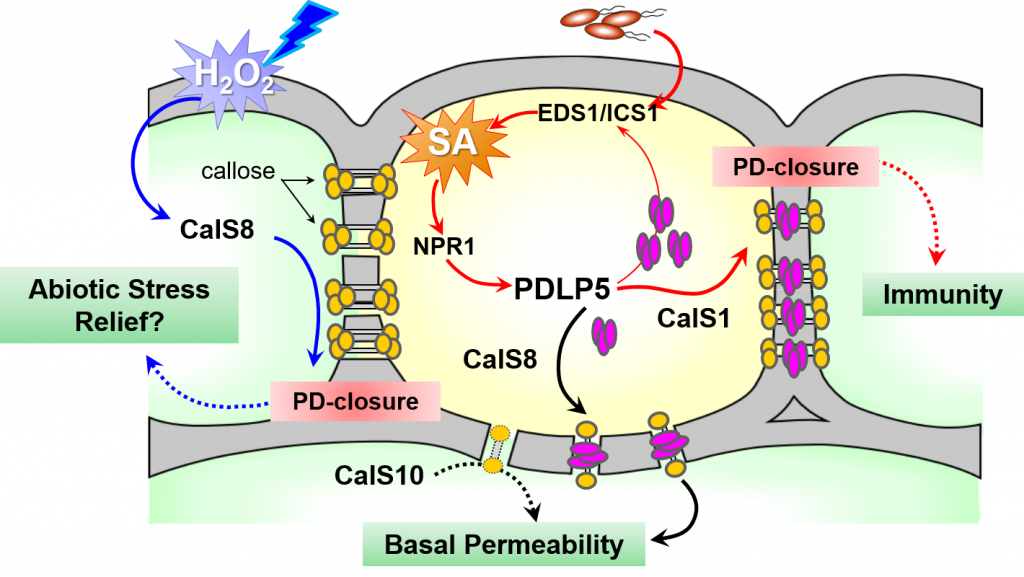Research
We are interested in elucidating the molecular mechanisms and components of cell-to-cell communication through plasmodesmal channels in plants. We are also interested in understanding how various cellular signals and environmental stresses are integrated with plasmodesmal regulation and what are the physiological or developmental consequences when spatiotemporal or systemic plasmodesmal dynamics are perturbed. Traditionally plasmodesmata were viewed as passive structures that many molecules can pass through including pathogens. We have found that plants have evolved to integrate various cellular signaling pathways, for example, immune signaling, with a plasmodesmal controlling system. This supracellular signaling allows for a rapid closure of plasmodesmata locally and systemically throughout the plant in response to pathogenic intrusion (see the figure below).
Our long-term research goals include identifying molecular components that associate with plasmodesmata with the focus on mapping their position and role in integrative signaling pathways in which cell-to-cell communication through plasmodesmata plays central roles. To comprehend the molecular basis for this essential process in plants, we are taking a multidisciplinary approach employing cellular, molecular, biochemical, proteomics, genetics and computational tools. We envision that the knowledge gained from these studies will not only contribute to the newly emerging field of intercellular signaling but also help understand the complexity associated with the plant system in general.
Funding
Current research projects in the Lee Laboratory are supported by the Division of Molecular and Cellular Biology and the Division of Integrative Organismal Systems of the National Science Foundation.
Award #1820103 (Lee, PI)
Toward the molecular unpacking of the PaaC domain, a novel Plasmodesmata-association & activation Cassette
Award #1457121 (Lee,co-PI)
Examining the Importance of Dynamic Trafficking in Systemic Acquired Resistance
Selected Recent Publications
Lee, J.-Y. and M. Frank (2018). Plasmodesmata in Phloem: Different gateways for different cargoes Curr Opin Plant Biol 43:119-124.
Ross-Elliott, T.J. et. al. (2017). Phloem unloading in Arabidopsis roots is convective and regulated by the phloem-pole pericycle, eLife, (10.7554/eLife.24125).
Lim, G.-H., et al. (2016). Plasmodesmata localizing proteins regulate transport and signaling during systemic immunity Cell Host & Microbe. 19:541–549.
Cui, W., and Lee, J.-Y. (2016). Arabidopsis callosesynthases Cals1/8 regulate plasmodesmal permeability during stress. Nature Plants 2:1603 doi:10.1038/nplants. 2016.34.
Lee, J.-Y. (2015). Plasmodesmata: a signaling hub at the cellular boundary. Curr. Opin. Plant Biol. 27:133-140.
Sager, R. and Lee, J.-Y. (2014). Plasmodesmata in integrative cell signaling. J. Exp. Bot. 65:6337-6358.
Lee, J.-Y. (2014). New and old roles of plasmodesmata in immunity and parallels to tunneling nanotubes. Plant Sci. 221:13-20.
Wang, X., et al. (2013). Salicylic acid regulates cell-to-cell communication during innate immune responses in Arabidopsis. Plant Cell, 25:2315-2329.
Lee, J.-Y., et al. (2011). A Plasmodesmata-Localized Protein Mediates Crosstalk between Cell-to-Cell Communication and Innate Immunity in Arabidopsis. Plant Cell 23:3353-3373.
**************
For a complete list of publications, please visit:
https://scholar.google.com/citations?user=yCG9SjQAAAAJ&hl=en



